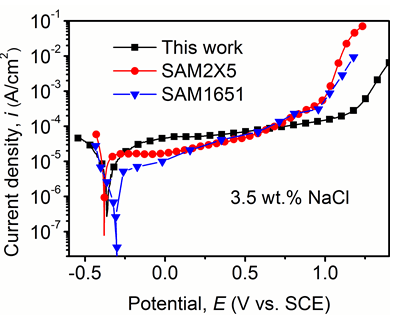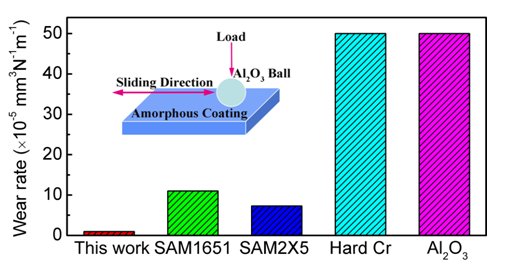Fe-based amorphous alloys have attracted worldwide attention because of their excellent soft magnetic properties, high fracture strength, and good corrosion resistance. However, the application is largely restricted due to their poor glass-forming ability (GFA) and low plasticity at room temperature. Preparation of amorphous coating using high velocity oxygen/air fuel (HVOF and HVAF) is one of the effective methods to solve the above application bottlenecks.
The soft-magnetic amorphous materials group in Ningbo Institute of Materials Technology & Engineering, CAS has been committed to the development and application research of new amorphous alloy materials. Recently, based on the shortage of the well-known SAM series alloys, the group developed a series of novel Fe-based bulk amorphous alloys with low cost, high glass-formation ability, high corrosion resistance and wears resistance, and then prepared high quality amorphous HVOF and AC-HVAF coatings. The microstructure, corrosion and wear resistance of the coatings were studied in detail using X-ray diffractometer (XRD), scanning electron microscope (SEM), differential scanning calorimetry (DSC), micro Vickers hardness tester, electrochemical workstation, friction and wear testing machine etc. The main results can be summarized as follows:
First of all, the Fe71Mo3.5Ni5P10C4B4Si2.5 alloy was chosen as the base alloy, and a series of large-sized Fe-based amorphous rods were obtained through micro-alloying Cr and optimizing composition ratio. Upon adding an appropriate amount of Cr into the base alloy, the thermal stability the alloy was improved, but decreased with more Cr. The electrochemical measurements performed in 3.5 wt.% NaCl solution show that the corrosion resistance was significantly improved by alloying a small amount of Cr, while for more than 8 at.% Cr the alloys exhibited similar corrosion behavior to each other. More Cr slightly decreases the thermal stability and corrosion resistance due to the precipitation of nanocrystalline phases. The best corrosion resistance is obtained for the x = 12 alloy, which could be attributed to the formation of a relatively thicker oxide film. (Mater. Des., 95 (2016) 225-230 ).
Secondly, the Fe71Mo3.5Ni5P10C4B4Si2.5 alloy with comparable corrosion resistance with the amorphous steel (Fe48Cr15Mo14C15B6Y2) was chosen as the thermal spraying material due to its high GFA, good mechanical and corrosion properties. The results showed that nearly spherical powders with high amorphous content and low oxygen could be obtained by Ar atomization process. By optimizing the process parameters, the HVOF and AC-HVAF coatings exhibited high amorphous content, low porosity and oxygen content, and high binding strength with the matrix. However, AC-HVAF coatings showed higher oxygen content, lower porosity and oxygen than those of HVOF coatings, indicating that AC-HVAF is more suitable for the preparation of high-quality Fe-base amorphous coatings compared with HVOF.(Mater. Sci. Technol., 2016, DOI:10.1080/02670836.2016.1160195).
Finally, the corrosion resistance, friction and wear properties of Fe68Cr8Mo3.5Ni5P10C4B4Si2.5 amorphous coatings were investigated in detail. The electrochemical measurements performed in 3.5 wt.% NaCl solution showed that the HVOF and AC-HVAF coatings exhibited similar corrosion current density and corrosion potential. However, the AC-HVAF coatings displayed an order lower passivation current density compared with the HVOF coatings, which mainly resulted from the higher content of amorphous and lower porosity. The dry friction and wear test at room temperature showed that the wear resistance of the coatings was 2-3 times higher than stainless steel, plasma spraying aluminum oxide coating and plating hard Cr coating. (Surf. Eng., 2016, DOI: 10.1080/02670844.2016.1176718).
The novel Fe68Cr8Mo3.5Ni5P10C4B4Si2.5 amorphous coatings showed comparable corrosion and wear resistance compared with the well-known SAM2X5 (Fe49.7Cr17.7Mn1.9Mo7.4W1.6B15.2C3.8Si2.4) and SAM1651 (Fe48Mo14Cr15Y2C15B6) amorphous coatings, despite the absence of W and low Mo and Cr content. This is good for further expanding the application field of Fe-based amorphous coatings.
This work was supported by National Natural Science Foundation of China (Grant Nos. 51501210 and 51571207) and Ningbo Municipal Nature Science Foundation (Grant Nos. 2015A610002).

Potentiodynamic polarization curves in 3.5 wt.% NaCl solution at room temperature for: (a) Fe71–xCrxMo3.5Ni5P10C4B4Si2.5 (x = 0, 4, 8, 10, 12, 14 at.%) amorphous ribbons, (b) x=8 alloy (Fe69.88Cr8.26Mo6.67Ni5.83P6.15C0.95B0.86Si1.4 wt.%), super duplex stainless steels UNS S32750 (Fe62.99Cr25.15Mo3.43Ni6.74P0.03C0.02Si0.55N0.27Mn0.69Cu0.13 wt.%), austenitic steel AISI 316L (Fe65.16Cr17.54Mo2.47Ni12.3P0.02C0.03Si0.44Mn1.84 wt.%), and amorphous steel (Fe51.29Cr14.92Mo25.7C3.45B1.24Y3.4 wt.%) obtained from this work and Ref. 20. The chemical compositions are given in mass percent for comparison.

Potentiodynamic polarization curves of Fe68Cr8Mo3.5Ni5P10C4B4Si2.5, SAM2X5 and SAM1651 amorphous coatings in 3.5 wt.% NaCl solution at room temperature

Wear rate of Fe68Cr8Mo3.5Ni5P10C4B4Si2.5, SAM2X5 and SAM1651 amorphous coatings, Hard Cr, and Al2O3 during dry sliding
professor Jiawei Li: lijw@nimte.ac.cn
All Images by ![]()

